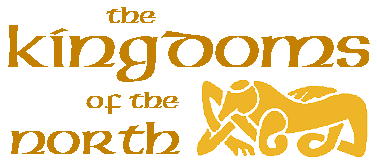
EBK Home
Kingdoms
Royalty
Saints
Pedigrees
Archaeology
King Arthur
Mail David

The Early British Kings of what is now Northern England, descend from one of two dynasties commonly known as the Gwyr-y-Gogledd, a Welsh phrase meaning the "Men of the North". They were a P-Celtic people, like the Cymri, who retained their independence from Saxon oppression for a number of centuries, in the relative remote Northern regions of Britain.
Welsh tradition holds that they all had a common ancestor in Old King Cole of nursery rhyme fame. He appears in ancient records as Coel Hen (the Old) and his name seems to ultimately derive from the Roman, Coellius. This fits in well with the time period in which it has been calculated that he lived: right at the end of the Roman administration (very late 4th century).
Considering the regions over which Coel's supposed descendants ruled, his own sphere of influence must have covered a vast area from Hadrian's Wall to the Southern Pennines. In fact, the exact area that would have been governed at this time by the Dux Britanniarum, a Roman official in charge of the military defence of Northern Britain. With his headquarters at York, he would have been in an ideal position to extend some semblance of Roman-type authority into the 5th century, long after the army and administration had returned to Italy.
Traditional Celtic law insists upon the division of land amongst sons upon the death of the landowner and this situation can certainly be traced amongst the kingdoms which emerged from Coel's domain. However, whether these men were really sons and grandsons of this powerful dux or merely early founders, attached to the great man by later generations is unknown.
According to tradition and early records, the North thus split into many different kingdoms. Ebrauc or British York was centred on that city. Bryneich became the later Saxon kingdom of Bernicia. There were little known kingdoms in the Pennines and the oft-quoted Elmet, around Leeds, whose name is retained today in places like Sherburn-in-Elmet. Others moved further south to establish Calchfynedd. Most powerful was perhaps the kingdom of Rheged, later divided into North and South. Its Kings, such as Urien and Owein, were long celebrated in Welsh poetry and, in medieval times, found their way into the Arthurian tradition. The area they ruled is still called Cumbria today, a name meaning 'Land of the Welsh'.
By the mid-7th century, however, the local Germanic settlers had completely overrun the North. Internal squabbles had weakened the British position in the region and the relatively few Saxons warriors were easily able to take advantage of the situation. Eventually only Rheged was left and a dynastic marriage brought this too into the English fold.
